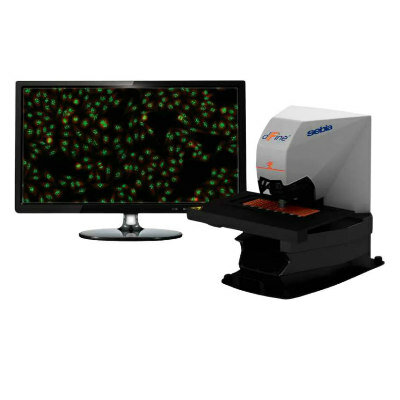Ovarian Cancer Protein Contributes to Alzheimer`s Disease Neurodegeneration
|
By LabMedica International staff writers Posted on 30 Jan 2020 |
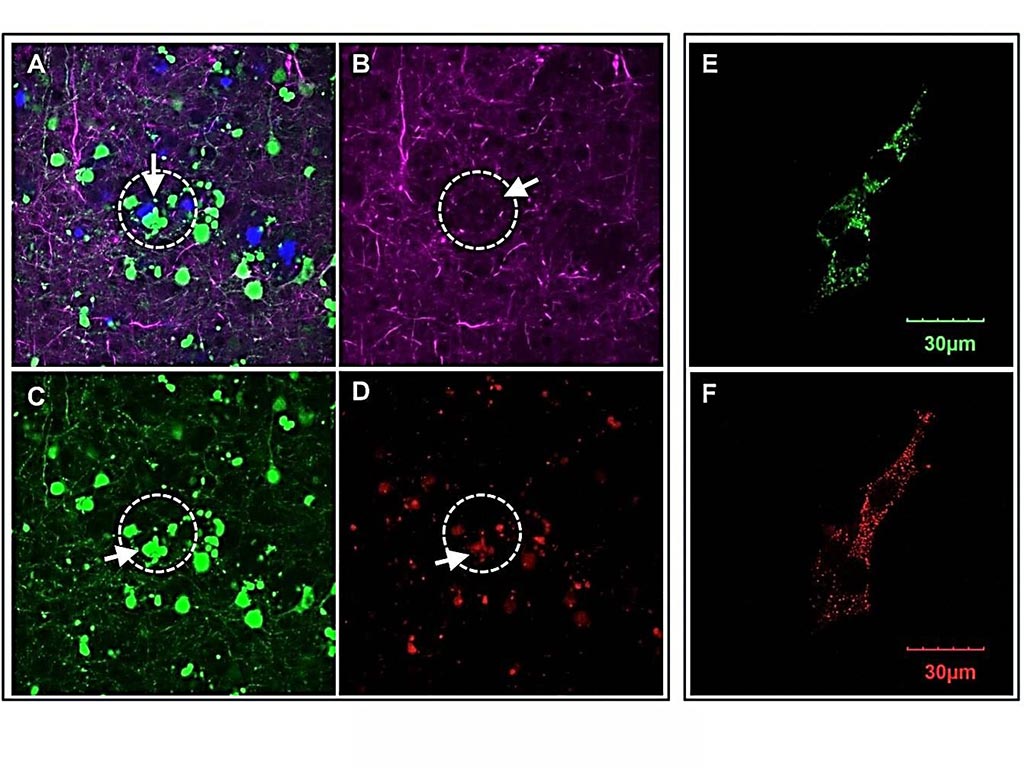
Image: In the brain of mice with Alzheimer\'s, areas near amyloid plaques (A) appear with fewer neural networks (B), dying neurons (C) and higher OCIAD1 (D). In cultured neuronal cells, the OCIAD1 proteins (E) appear in the mitochondria (F) (Photo courtesy of Houston Methodist Research Institute).
Alzheimer's disease is a complex neurological disorder with pathological hallmarks of hyperamyloidosis (senile plaques), neurofibrillary tangles containing hyperphosphorylated tau, and extensive neurodegeneration in the brain.
Alzheimer's disease (AD) pathogenesis remains elusive and no effective therapy is available. Neurodegeneration, including synaptic damage and neuronal loss, forms the basis of dementia in AD, and certain brain regions are more vulnerable during disease progression.
Scientists at the Houston Methodist Research Institute (Houston, TX, USA) and their colleagues reported on a new role of ovarian cancer immune-reactive antigen domain containing 1 (OCIAD1). Originally discovered for its effect on ovarian cancer metastasis and stem cell metabolisms, the group found the OCIAD1 protein in human brain cells, and determined it impairs neurons and damages synapses in the brain, contributing to neurodegeneration in Alzheimer's disease.
The investigators culled through archived bioinformatics data of brain tissue from deceased Alzheimer's patients, as well as mouse models by blending computational methods with laboratory studies. They determined that OCIAD1 plays a role in the disease's progressive neurodegeneration by impairing mitochondria function. Known as the powerhouse of cells, damage to mitochondria results in the trickle-down cell death effect in the brain leading to neuron damage.
Higher levels of OCIAD1, found in vulnerable brain areas and dystrophic neurites, were correlated with disease severity. Multiple early AD pathological events, particularly Aβ/GSK-3β signaling, elevated OCIAD1, which in turn interacts with BCL-2 to impair mitochondrial function and facilitates mitochondria-associated neuronal injury. Notably, elevated OCIAD1 by Aβ increases cell susceptibility to other AD pathological challenges.
Xuping Li, PhD, an instructor of Neurodegeneration in Oncology and co-corresponding author, said, “We applied a system biology strategy to see if we could find a different mechanism of neurodegeneration in Alzheimer's disease. We identified OCIAD1 as a new neurodegeneration-relevant factor, predicted its function, and demonstrated it mediates the long-term impact of amyloid beta on cells and synaptic damages by impairing mitochondria function.” The study was published on January 12, 2020 in the journal EBioMedicine.
Related Links:
Houston Methodist Research Institute
Alzheimer's disease (AD) pathogenesis remains elusive and no effective therapy is available. Neurodegeneration, including synaptic damage and neuronal loss, forms the basis of dementia in AD, and certain brain regions are more vulnerable during disease progression.
Scientists at the Houston Methodist Research Institute (Houston, TX, USA) and their colleagues reported on a new role of ovarian cancer immune-reactive antigen domain containing 1 (OCIAD1). Originally discovered for its effect on ovarian cancer metastasis and stem cell metabolisms, the group found the OCIAD1 protein in human brain cells, and determined it impairs neurons and damages synapses in the brain, contributing to neurodegeneration in Alzheimer's disease.
The investigators culled through archived bioinformatics data of brain tissue from deceased Alzheimer's patients, as well as mouse models by blending computational methods with laboratory studies. They determined that OCIAD1 plays a role in the disease's progressive neurodegeneration by impairing mitochondria function. Known as the powerhouse of cells, damage to mitochondria results in the trickle-down cell death effect in the brain leading to neuron damage.
Higher levels of OCIAD1, found in vulnerable brain areas and dystrophic neurites, were correlated with disease severity. Multiple early AD pathological events, particularly Aβ/GSK-3β signaling, elevated OCIAD1, which in turn interacts with BCL-2 to impair mitochondrial function and facilitates mitochondria-associated neuronal injury. Notably, elevated OCIAD1 by Aβ increases cell susceptibility to other AD pathological challenges.
Xuping Li, PhD, an instructor of Neurodegeneration in Oncology and co-corresponding author, said, “We applied a system biology strategy to see if we could find a different mechanism of neurodegeneration in Alzheimer's disease. We identified OCIAD1 as a new neurodegeneration-relevant factor, predicted its function, and demonstrated it mediates the long-term impact of amyloid beta on cells and synaptic damages by impairing mitochondria function.” The study was published on January 12, 2020 in the journal EBioMedicine.
Related Links:
Houston Methodist Research Institute
Latest Pathology News
- Novel Method Tracks Cancer Treatment in Cells Without Dyes or Labels
- New AI-Based Method Effectively Identifies Disease Phenotypes Using Light-Based Imaging
- AI Accurately Predicts Genetic Mutations from Routine Pathology Slides for Faster Cancer Care
- AI Tool Enhances Interpretation of Tissue Samples by Pathologists
- AI-Assisted Technique Tracks Cells Damaged from Injury, Aging and Disease
- Novel Fluorescent Probe Shows Potential in Precision Cancer Diagnostics and Fluorescence-Guided Surgery
- New Lab Model to Help Find Treatments for Aggressive Blood Cancer
- AI-Supported Microscopy Improves Detection of Intestinal Parasite Infections
- AI Performs Virtual Tissue Staining at Super-Resolution
- AI-Driven Preliminary Testing for Pancreatic Cancer Enhances Prognosis
- Cancer Chip Accurately Predicts Patient-Specific Chemotherapy Response
- Clinical AI Solution for Automatic Breast Cancer Grading Improves Diagnostic Accuracy
- Saliva-Based Testing to Enable Early Detection of Cancer, Heart Disease or Parkinson’s
- Advances in Monkeypox Virus Diagnostics to Improve Management of Future Outbreaks
- Nanoneedle-Studded Patch Could Eliminate Painful and Invasive Biopsies
- AI Cancer Classification Tool to Drive Targeted Treatments
Channels
Molecular Diagnostics
view channel
RNA Screening Test Could Detect Colon Polyps Before They Become Cancerous
Colorectal cancer has become a growing health crisis, especially as it increasingly affects younger adults in their 20s, 30s, and 40s, while screening rates remain low. Colorectal cancer is now the leading... Read more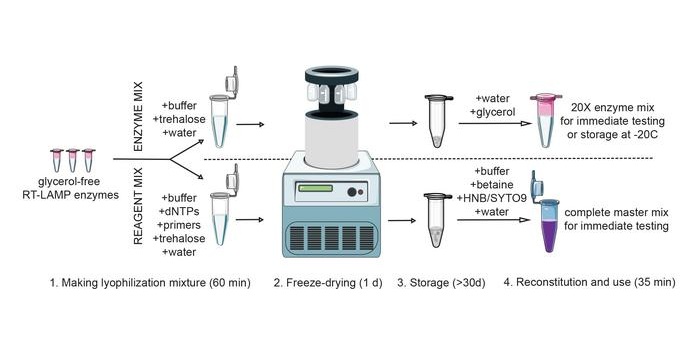
New RT-LAMP Assay Offers Affordable and Reliable Pathogen Detection for Resource-Limited Settings
The high cost and logistical complexities associated with rapid, point-of-care tests have long hampered widespread access to molecular diagnostics, especially in low- and middle-income countries.... Read more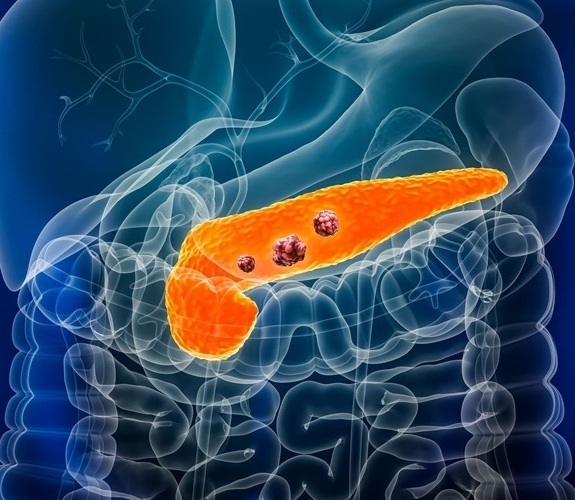
New Biomarker Panel to Enable Early Detection of Pancreatic Cancer
Pancreatic cancer (PC) has one of the worst prognoses globally, with only 13% of diagnosed patients surviving for five years or more. In Ireland, there are about 900 cases of pancreatic cancer annually,... Read more
Ultrarapid Whole Genome Sequencing for Neonatal and Pediatric Patients Delivers Results In 48 Hours
Genetic diseases are the leading identifiable cause of infant mortality, and early diagnosis is crucial to improve patient outcomes. In the neonatal and pediatric intensive care units (NICU and PICU),... Read moreHematology
view channel
Disposable Cartridge-Based Test Delivers Rapid and Accurate CBC Results
Complete Blood Count (CBC) is one of the most commonly ordered lab tests, crucial for diagnosing diseases, monitoring therapies, and conducting routine health screenings. However, more than 90% of physician... Read more
First Point-of-Care Heparin Monitoring Test Provides Results in Under 15 Minutes
Heparin dosing requires careful management to avoid both bleeding and clotting complications. In high-risk situations like extracorporeal membrane oxygenation (ECMO), mortality rates can reach about 50%,... Read moreImmunology
view channel
Evolutionary Clinical Trial to Identify Novel Biomarker-Driven Therapies for Metastatic Breast Cancer
Metastatic breast cancer, which occurs when cancer spreads from the breast to other parts of the body, is one of the most difficult cancers to treat. Nearly 90% of patients with metastatic cancer will... Read more
Groundbreaking Lateral Flow Test Quantifies Nucleosomes in Whole Venous Blood in Minutes
Diagnosing immune disruptions quickly and accurately is crucial in conditions such as sepsis, where timely intervention is critical for patient survival. Traditional testing methods can be slow, expensive,... Read moreMicrobiology
view channel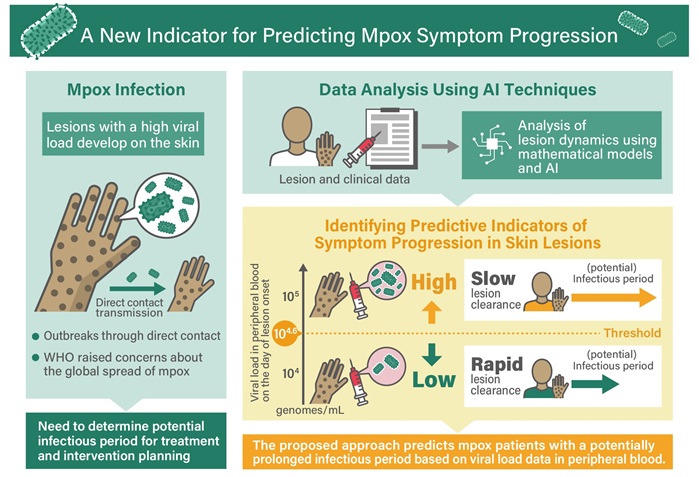
Viral Load Tests Can Help Predict Mpox Severity
Mpox is a viral infection that causes flu-like symptoms and a characteristic rash, which evolves significantly over time and varies between patients. The disease spreads mainly through direct contact with... Read more
Gut Microbiota Analysis Enables Early and Non-Invasive Detection of Gestational Diabetes
Gestational diabetes mellitus is a common metabolic disorder marked by abnormal glucose metabolism during pregnancy, typically emerging in the mid to late stages. It significantly heightens the risk of... Read morePathology
view channel
Novel Method Tracks Cancer Treatment in Cells Without Dyes or Labels
Multiple myeloma is a blood cancer that affects plasma cells in the bone marrow, leading to abnormal protein production, weakened immunity, and organ damage. Traditional methods for evaluating myeloma... Read more
New AI-Based Method Effectively Identifies Disease Phenotypes Using Light-Based Imaging
Precision medicine, where treatment strategies are tailored to a patient's unique disease characteristics, holds great promise for cancer therapy. However, identifying disease phenotypes, which are critical... Read more
AI Accurately Predicts Genetic Mutations from Routine Pathology Slides for Faster Cancer Care
Current cancer treatment decisions are often guided by genetic testing, which can be expensive, time-consuming, and not always available at leading hospitals. For patients with lung adenocarcinoma, a critical... Read moreTechnology
view channel
Multifunctional Nanomaterial Simultaneously Performs Cancer Diagnosis, Treatment, and Immune Activation
Cancer treatments, including surgery, radiation therapy, and chemotherapy, have significant limitations. These treatments not only target cancerous areas but also damage healthy tissues, causing side effects... Read more
Ultra-Sensitive Biosensor Based on Light and AI Enables Early Cancer Diagnosis
Cancer diagnosis is often delayed due to the difficulty in detecting early-stage cancer markers. In particular, the concentration of methylated DNA in the bloodstream during the early stages of cancer... Read moreIndustry
view channel
BD Biosciences & Diagnostic Solutions to Merge with Waters
BD (Becton, Dickinson and Company, Franklin Lakes, NJ, USA) and Waters Corporation (Milford, MA, USA) have entered into a definitive agreement to combine BD's Biosciences & Diagnostic Solutions... Read more









